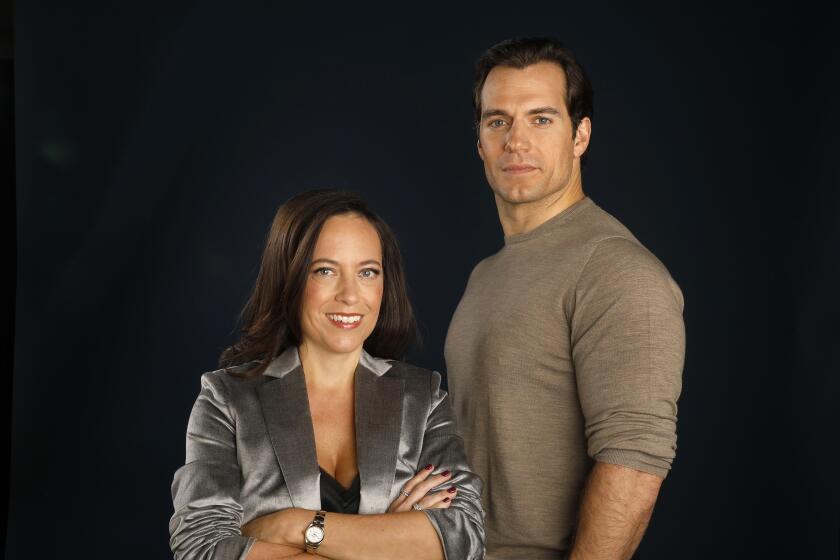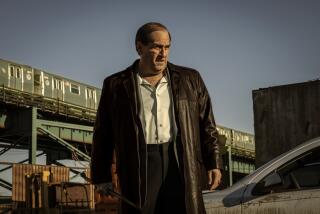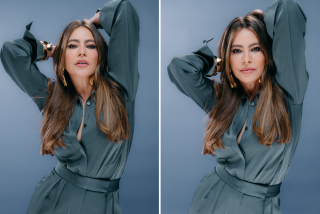Netflix’s new fantasy series spliced together beloved books. The makers explain why
The following story contains spoilers from Netflix’s “Shadow and Bone.”
The excitement began with a video announcement over a year ago.
“Hello, welcome to the Grishaverse,” the one-minute video began. “My name’s Jessie Mei Li, and I’m playing Alina.”
Fans of author Leigh Bardugo’s Grisha trilogy and “Six of Crows” duology knew instantly what this meant: the book-to-television adaptation was underway.
Adapted by showrunner Eric Heisserer, screenwriter of “Arrival” and “Bird Box,” the long-awaited fantasy series, which premieres Friday on Netflix, follows Alina (Li), a mapmaker, as she uncovers a secret power that has the potential to change her world. But the Grishaverse, named for the group of humans, or Grisha, who manipulate matter, is filled with thieves, liars, villains and antiheroes who, after catching wind of Alina’s abilities, intend to turn her powers to their own purposes.
Turning the beloved book series into a TV show necessitated a number of changes, though. Bardugo and Heisserer explained several of the most important to The Times.
Introducing General Kirigan
General Aleksander Kirigan (played by “The Chronicles of Narnia” and “Westworld” veteran Ben Barnes) is the feared leader of the Grisha Second Army, a powerful shadow summoner able to harness and control darkness.
But his name may be unfamiliar to fans who know the antagonist primarily as the Darkling throughout the trilogy, until his name is revealed in the final book. Heisserer wanted to make clear to the audience the real origins behind the character, so “giving him a different surname allowed [the creative team] to play into that con better.”
“You can get away with things on the page, particularly in first-person POV, that simply do not work on the screen,” Bardugo said. “And I think that the kind of conversational gymnastics the characters would have had to engage in without having a proper name to call him, with Alina not having a proper name to call him, would have been quite challenging. And the fundamental betrayal, the fundamental knowledge of the lies he’s telling her, I think become actually more poignant when he’s offered her this intimacy of his first name so early.”
Historians help us sort through fact and fiction in executive producer Shonda Rhimes’ saucy Netflix drama about the 19th century English marriage market.
In the Grisha books the Darkling’s backstory is a complicated labyrinth because the trilogy is narrated from Alina’s first-person perspective. All of his motives, ambitions and betrayals are discovered through Alina‘s own experiences or what she’s told by others.
In the series, by contrast, Kirigan’s backstory is developed through conversations with Baghra (Zoë Wanamaker), a Grisha instructor, and his relationships with other characters in the series, a closer perspective than in the books. (Bardugo and Heisserer hoped to include more of her Darkling prequel “The Demon in the Woods” in the television series, but “a number of things conspired against” them doing so, Heisserer said.)
Inej and the Menagerie
In “Six of Crows” we meet Inej Ghafa as the Wraith — a skilled acrobat who works with criminal mastermind Kaz Brekker.
Unlike the Grisha trilogy, in “Six of Crows” each of the characters takes readers through their own personal journey. Piece by piece, Inej reveals her experience at the Menagerie, a brothel run by Tante Heleen in Ketterdam, the city where the duology takes place.
Inej suffers severe trauma at the Menagerie, which is referred to in the books as the “House of Exotics.” People who are held at the Menagerie are forced to get a tattoo of a peacock feather, which Inej scrapes off the moment Kaz pays off Heleen to end her indenture, thereby freeing her.
In the Netflix series, Inej, played by Amita Suman, is still employed at the Menagerie, walking a tightrope between working for both Kaz and Heleen. And she still has the tattoo of the peacock feather on her wrist.
Henry Cavill and Lauren Schmidt Hissrich discuss Netflix’s spin on the fantasy book series “The Witcher,” which has also spawned a video game franchise.
Bardugo said the change is designed to allow “Six of Crows” characters to “progress and have an arc so that they didn’t stay static in that first season.”
“We wanted to reach that point in ‘Six of Crows’ and earn it,” Heisserer said. “But we knew that we couldn’t start there ... and to have [Inej] still essentially be indentured and not fully paid off with Heleen really helpfully complicated matters for both of them and put the extra stakes on this story as they set up to do their mission.”
What it means for Alina to be half-Shu
Bardugo acknowledged that the original trilogy reflected the fantasy she had read before, which was straight and white. But as she grew as a writer, she felt “much more confident in reflecting our world more authentically.”
As they were setting out to bring the books to life, she and Heisserer wanted to ensure the cast reflected the diversity of the real world, and that meant portraying protagonist Alina as half-Shu in the Netflix series.
That means Alina has Shu Han ancestry, referring to a fictional border country in the Grisha trilogy that takes after the nations of Central Asia. (The narrative’s Ravka setting, on the other hand, is modeled after imperial Russia.) Actress Jessie Mei Li is of mixed Chinese ancestry.
“Alina’s born in a border town. It makes perfect sense that she would be half-Shu,” Bardugo said, referring to the south Ravkan town of Keramzin where Alina grew up in an orphanage. Keramzin is “this place where the border shifts, depending on who’s winning the war, and where people fall in love, and they get married or they start businesses. The kings and queens make these decisions, generals enforce them, but people are forced to live with them.”
Despite the cloud over creator Joss Whedon, HBO’s Victorian sci-fi/fantasy drama is a worthy successor to “True Blood,” “Game of Thrones” and “Watchmen.”
As a result of Alina’s half-Shu identity, her character regularly faces racism. She is told “you stink of the orphanage, half-breed,” referred to as a “rice eater” and is instructed to step to the back of the line after being recognized as half-Shu, among other indignities.
In order to bring nuance and understanding to Alina’s experience, Bardugo and Heisserer relied on their writers room, which Bardugo said was more than half composed of mixed race staffers “who could bring their own experiences to these characters” and write material that would “feel more authentic” to the actors.
“I don’t set out to give a message. I set out to tell a story as honestly as I possibly can. And to talk about countries at war, and to talk about countries with centuries-old prejudices and not address these things would feel dishonest,” Bardugo said. “And I think readers would pick up on it, and viewers would pick up on it.”
“When I talk about the show, I talk about it as ‘our show’ — as something that we built together. And that’s not just me and Leigh but it’s all the other writers, the creative team, the department heads, and certainly the cast,” Heisserer added. “And that’s really what helped inform the way the show evolved and emerged. It was really our job — my job, specifically — most of the time to listen with empathy.”
A crossover to rival Marvel
Netflix’s “Shadow and Bone” is ambitious by design; it combines characters from the “Six of Crows” books into the intricate world of the Grisha trilogy to create an “‘Ocean’s Eleven’ meets ‘Game of Thrones’” storyline, Heisserer has said.
Heisserer said that intertwining characters from both book series allowed the viewer to explore the entire Grishaverse, from the bustling streets of Ketterdam to the ornate halls of the Little Palace.
Bardugo already cross-pollinates characters throughout the Grishaverse, Heisserer said, so he didn’t feel like he was manipulating or breaking any rules of the world. The opportunity to tell both storylines also worked thematically.
“There’s a really compelling, underlying theme that ties Alina, Mal and a number of Crows together,” Heisserer said, referring to characters played by Archie Renaux, Freddy Carter, Kit Young and Suman. “They’re all searching for where they belong, and what is within their power. And some of them find that there’s a lot more than they expected.”
Heading into the finale of “The Falcon and the Winter Soldier,” we dig into the comic book history behind its tale of race and superheroes in America.
For Bardugo, it was refreshing to see Alina’s journey through the eyes of the characters from “Six of Crows.”
“These are people who are not royal. They don’t have grand destinies. They don’t have tremendous magical power, as far as we’re aware,” Bardugo said. “It’s a very different kind of path that they’re walking and they occupy a different space in the world.”
While it was a challenge to weave together the storylines, Bardugo and Heisserer wanted to ensure they were protecting Alina’s agency throughout the show. Their aim wasn’t to “Frankenstein” the plot of the books together, as Bardugo puts it, but to tell a compelling story.
“I didn’t want to go backwards,” Bardugo said. “I wanted to know what we could forge forward together with something that was going to be exciting for us to work on, for the writers to work on, to provide opportunities to do some fun, daring storytelling, instead of trying to do a page-by-page adaptation. What’s the point of that?”
More to Read
The complete guide to home viewing
Get Screen Gab for everything about the TV shows and streaming movies everyone’s talking about.
You may occasionally receive promotional content from the Los Angeles Times.








